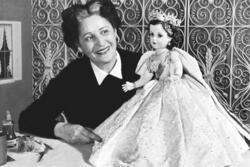From Barbie to Kamala: “Little Girls, Dream Big”
In my house, girls are in charge. I was raised to believe that women can do anything that men can do (if not more). Growing up, my sisters and I spent a lot of time playing with dolls. Between my mom and aunts’ childhood dolls and our American Girl dolls, our house was flooded with them. Our playroom had bins full of Barbies with miniature clothes for every occasion. Every moment I spent in that playroom dressing my dolls, I lived in my imagination—and imagined through my Barbies what my future might hold.
This space for imagination that I had as a young girl was exactly Ruth Handler’s goal with her invention of Barbie. Handler, a Polish Jew, tried to encourage little girls to pursue any path they wanted to. In the 1950s, dolls available in the United States were mostly babies, mothers, or housewife characters. Through Barbie, Ruth Handler created a toy that allowed girls to imagine and play as women with real and diverse lives and, later, occupations.
But while Handler’s original intent was to promote girls’ imaginations, something quite positive, the Barbie brand came to symbolize something quite negative. Perhaps most notably, Barbie’s unrealistic body type garnered a lot of criticism for providing an impractical model for young girls about female beauty norms. Barbie has caused many children to strive for an “ideal” body type that is far from realistic; a 2006 study found that girls who played with Barbies showed more concern about being slim than those who played with other dolls. The Barbie beauty standard only contributes to a culture in which girls are encouraged to be dissatisfied with their bodies from a young age.
The first iteration of the Barbie doll was a white, blonde, unnaturally slim woman (with no diversity in terms of body type, skin color, ability, etc.). This depiction didn’t account for or represent the diverse demographics within the United States and the world and Mattel, Barbie’s manufacturer, received an overwhelming amount of criticism for this choice. Eventually, Mattel made changes to their product and expanded body types and skin tones for their dolls. 55 percent of the dolls sold around the world today don’t have blonde hair or blue eyes.
Just as Barbie’s manufacturer Mattel has developed and expanded its dolls to represent broader diversity, we as a society need to continue working towards equality and representation. As little girls, we are told that we can do many different things. Across the country, girls are able to dress Barbie as a president and invent a life for their doll president. Yet, in reality, the United States of America has yet to have a woman leading our country. Growing up, I didn’t learn about the underlying sexism in our country; instead, I was told to dream. Little girls look to Barbies to imagine who they will be as women. Yet, as these girls grow up, their dreams become increasingly impossible because of the way our country is built. As Barbie continues to develop and offer more progressive visions for the children who play with her, our country should be doing just the same.
Kamala Harris’s election is one example of this; just a few months ago, she made history. Kamala Harris became the first female Vice President-elect of the United States, as well as the first Asian American and first Black American Vice President-elect. Harris proved to girls across the country that we are taking real steps toward representation and equality. In her acceptance speech, Harris stated, "While I may be the first woman in this office, I will not be the last—because every little girl watching tonight sees that this is a country of possibilities.” As Harris shattered barriers, she recognized the importance of girls having real role models—a continuation of Ruth Handler’s original dream of representation. While these women have given us the tools to dream big and have shown us that these dreams can become reality, there is still much more to be done. So let’s get to work.
This piece was written as part of JWA’s Rising Voices Fellowship.







